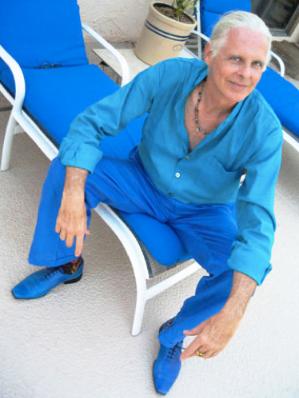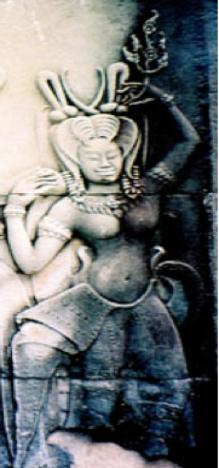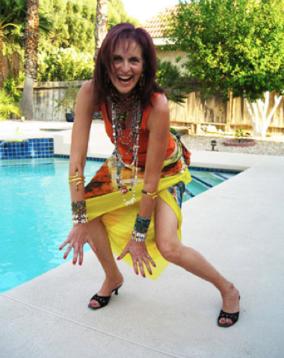| ADORNED JEWELLERY VISION MAGAZINE ARTICLE |
| In July we went to St Tropez to meet with a new jewellery collector. On a back street away from the bling merchants, the signature jewellery galleries and the big name gem boutiques, we found a store that sells Tibetan jewellery. So ancient and yet so modern. The owner, Pierre, is passionate about old amber and coral, because he finds in it a beauty and a spirit that is new. And people are buying, there is a crowd in the shop listening to Pierre talk. What can we say, in the glitter capital of the world, about a jeweller who uses the words “spiritual” and “fashionable” in the same breath? Noelle and I design jewellery in Asia and sell it in the West. We make things, not for the market or for fashion, but for a world we imagine. In our world both men and women dress lavishly, wear talismans for protection and have a personal jeweller who combines the vision of an artist with the power of a shaman. A lot to ask, but in Asia this is already part of the jewellery tradition, Because we sell |
Article published in Vision Magazine, November, 2006. |


| Change happens suddenly, signaled by small things, easy to miss. We walked from the Tibetan jewellery store down to the water front, ordered a coffee and picked up the International Herald Tribune. Preoccupied with the headlines, we almost missed the article by David Colman-- “Must-have accessories for the spiritual man”. Colman quotes a number of stylish men about their jewellery. For them, it’s not just ornament. “It’s more something spiritual, that depicts periods of my growth, of growing up, of my life…I’m not a religious person, but I like the symbols and how they’ re layered… For me, it’s about the perfect non-denominational, archetypal symbol.” (July 26, 2006, p. 20.) It’s a small thing, men's jewellery, but I think that Colman has seen some cracks in the old world order, a moment when “toys for the boys” suddenly means something new. |
| Even the advertising slogans of jewellery giants like De Beers are recognizing a change. It’s a long way from “Diamonds are a Girl’s Best Friend” to “Women, Raise your Right Hand.” Jewellery for the left hand was once a token about woman’s desirability and man’s power, a left handed complement. But now, when women raise their right hand, they see jewels that symbolize independence, confidence and self admiration. Women are on the move. In the West, it has taken men a long time to get past the fraternity ring and the tie pin. Suddenly, the guy necklace is OK. Today we are all free to adorn ourselves, to be lavish with ornament, to bedeck, bejewel and bemuse ourselves with precious metals and gems. It doesn’t matter if we are male or female, rich or poor, it doesn’t matter if we are going to the ball or going to the post office, let’s dress up. |
| In the sixties we talked about birthing a new age, but it has been a long, long labour. It takes patience and remarkable skills to fashion a new consciousness. We have the tools, from psychology to psycho- anthropology, to understand our inhibitions. We have the will to become new. Why is it such slow work and how can we move forward? Our way is to travel. All over the world, we find people who live in old cultures, where daily life integrates with the spiritual. That is why we live in Bali. Every morning the clonk, clonk of the wooden kulkul calls the faithful to ceremony. The streets are lined with celebratory bamboo poles decorated with banana leaf cut-outs of the rice goddess. Many a sign warns, as you drive through villages: “Careful- Careful, Ritual in Progress”. When we came to Bali, we were surprised to see how important jewelry is to spirituality. Every Balinese, even the poorest, is saving to buy precious metals and gems to make ritual gifts of jewellery for children at coming of age |

| ceremonies. The wife wears elaborate, traditional earrings to celebrations, the husband wears his power ring. Even the westernized Balinese youth wear power jewellery. The motor cycle wild boy flashes his sacred dragon bracelet, the blooming teenage girl flaunts her amulet necklace. |
| The traveler can search for special cultures by moving around the globe. But it is also possible to travel back through time. Every year we search for inspiration from the past. This year we went to Cambodia to study 900 year old stone carvings, to photograph the beautiful Apsaras at the Hindu-Buddhist temple, Ankor Wat. The Apsara is such an old myth, from the Ramayana, told before Rome, before Athens, told while the West was still sleeping. The myth traveled slowly east from India, brought to Cambodia by missionaries, merchants and a lazy cultural drift. Imagine that the year is now 1120 AD, Suryavarman II is on the throne and Angkor Wat is rising. A Cambodian stone carver looks lovingly, lasciviously at his model. She wears the latest fashion, surreal, elaborately knotted hair, diaphanous cloth and lavish gold jewelry. She is a temple dancer, posing as the incarnation of a heavenly Apsara, who floats on clouds, born from the Sea of Milk, immortal, beautiful, smiling and beguiling. In her glory the Apsara reveals three essential principles: she is adored; she is adorned; she wants adoration. To love, to beautify, to worship an Apsara, the carver’s job, the warrior’s joy, the god- king’s hope. Carved beside her on the wall, a warrior guards the temple door, lavishly ornamented. Women and men, mortal and immortal, these people knew how to dress. Judging from the smile, the dance, the grace and the beauty, adornment has made them happy. |
| Compared to our troubled times, the reign of Suryavarman II, the builder of Angkor Wat, was not so different. It was, like ours, a world confused by superficial, ephemeral fashion and the erosion of traditions. The ruler pillaged the state treasury. There were ill advised wars with Thailand and Vietnam, earthquakes, famines and plagues. In spite of all that, the hundreds of Apsaras who dance on the walls of Angkor Wat tell us a joyous story, about an aesthetic stronger than death. One millennium later the rulers are gone, the cities ruined, the religion vanished, the history lost. What remains to us is the smiling Apsara, her silks and her jewels. Time has distilled her beauty. |

| Looking at Apsaras is inspiring. We design our jewelry by collecting images from every pantheon, all the Bodhisattvas, Ganeshas, Madonnas, Gods and Goddesses. We recarve them in lapis lazuli and amber, mammoth ivory and silver, surround them with gold and gems, drape them with necklaces of precious stone. From Asia, we bring these gifts to the West. We are in the transformation business, changing images and changing people. From antique and ancient materials, we make fine jewelry. The jewelry, in turn, connects people to primal traditions. This we call the aesthetics of fusion, world jewellery, power dressing with a difference. Break the taboo against knowing who you are, against wearing what you want. Put on an archetypal symbol, to protect, to heal, to empower. Jewellery is changing. Adornment becomes you. |

| at private showings, we have time to talk at length about jewellery with many people. In the past we have had to work hard to tell our story and “initiate” our clients, but this year more and more people already understand, they “get it”. Something is happening, something is changing. |